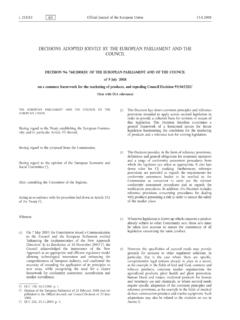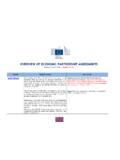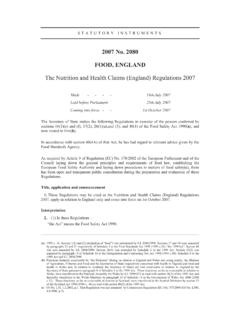Transcription of Environment fact sheet: REACH - Health and Safety …
1 european . COMMISSION. Environment fact sheet: REACH . a new chemicals policy for the EU. Modern society needs chemicals, and the EU chemicals industry is an important sec- tor for the EU's economy. But the production and wide-spread use of substances may pose risks to human Health and the Environment . The number of incidents of allergies, asthma, certain types of cancer, and reproductive disorders in Europe is increasing. It is sus- pected that chemicals are contributing to this trend, but we need more information. We know very little about our chemicals: for 99 % we don't have enough information about effects, uses and how they need to be handled to be safe.
2 The proposed new EU chemicals policy, REACH , will require producers and importers of chemicals to register them along with the information needed to use them safely. REACH will provide a high level of protection of human Health and the Environment . At the same time, it will enhance the competitive- ness of the EU chemicals industry by fos- tering innovation and ensuring high Safety standards for its products. Information about high-volume chemicals Potential negative effects of chemicals 5 FTUFE ..JOJNVN EBUB.. CBTF TFU. The number of incidents of /P EBUB . allergies, asthma, certain types . of cancer, and reproductive disorders, including low sperm counts, are on the increase in Europe.
3 Chemicals may be one of the causes. Some chemicals have endo- 7 FSZ MJUUMF EBUB . crine-disrupting properties, MFTT UIBO CBTF TFU. which means they mimic or . inhibit hormones. In some animals, such as frogs, birds, fish and molluscs, they have produced infertility and gender changes. In 2004, the environmental Fact 1: We need chemicals and a strong campaign group WWF tested industry the blood of government min- isters from 13 EU Member Today, chemicals are the basis of most of our products. They can make them States for chemicals that can soft or firm, washable or degradable, transparent or colourful, whatever the negatively affect human Health specific need.
4 Since 1930, global production of chemicals has risen from and wildlife. WWF found on 1 million tonnes to over 400 million tonnes annually. average 37 out of the 103 test- The chemicals industry is important to the EU economy. The chemicals ed substances in the ministers' sector is the third-largest manufacturing industry in the EU, encompassing blood (3). 31 000 companies that employ million people. Internationally, the EU. is the leading chemicals-producing area. In 2004, it accounted for 33 %. Some chemicals can travel long (EUR 580 billion) of global sales (EUR 1 736 billion) (1). distances. High levels of toxic chemicals have been found in Inuit and polar bears.
5 Chemi- cals can also accumulate in mothers' milk. Fact 2: Chemicals can pose risks, but information is sketchy Two studies commissioned by the european trade unions' Chemicals can have hazardous properties. They can be irritant, toxic and association ETUC show that a corrosive; and they can cause cancer, mutations and reproductive problems. third of all recognised occupa- The problem is that we know very little about the vast majority of the chemi- tional diseases in Europe are cals we use. related to exposure to chemi- In the EU, more than 100 106 chemicals were reported to be on the cals. The benefits of REACH market in 1981, which was the first and only time that the chemicals used for occupational skin and res- in the EU were listed.
6 Pirator diseases could range For 99 % of chemicals (by volume), information on properties, uses and from EUR 21 to 160 billion in risks is sketchy. Chemicals produced in high volumes (above 1 000 tonnes the next 30 years. (4). per year) have been examined more closely. Still, there are no data for about According to the EU Agency 21 % of those, and another 65 % come with insufficient data (2). for Safety and Health at Work, occupational skin diseases alone result in the loss of 3 million working days each year, valued at EUR 600 mil- (1) Fact and figures The european chemical industry in a worldwide perspective', January lion (5).
7 2005, CEFIC ( european Chemical Industry council ) ( ). (2) Public availability of data on EU high production volume chemicals', european Chemicals Bureau, Joint Research Centre, european Commission ( ). (3) Bad blood? A Survey of chemicals in the blood of european ministers', WWF, October 2004. ( ). (4) The impact of REACH on occupational Health ', School of Health and Related Research (University of Sheffield, UK), September 2005 and Skin sensitisers', Facts, Issue 40, european Agency for Safety and Health at Work, June 2003. (5) Fact 3: Current legislation does not provide the necessary level of protection Making the most of REACH : Current EU legislation on chemicals makes a distinction between: What will it bring?
8 Chemicals put on the market after 1981, so-called new substances'. (around 4 000 until now); and A high level of protection from the risks that chemicals may chemicals put on the market before 1981, so-called existing substances' pose to human Health and (100 106 substances). the Environment , through the To avoid risks, new substances must be tested and notified to the authorities generation and dissemination before they can be marketed. of information on chemicals, in With regard to the 100 106 existing substances, public authorities are in particular Safety information. charge of identifying the hazardous among them, prioritising those used in A sustainable and competi- highest volumes for risk assessment and, where needed, developing risk man- tive EU chemicals industry agement measures.
9 This is a complex procedure that depends on information that can innovate more eas- from industry. Since 1993, the european Commission and Member States ily and whose products meet have prioritised 141 high-volume chemicals, but the procedure has so far high Safety standards. This will been finalised for only 39 substances. increase consumer confidence, This system is unable to produce the level of protection that is needed. reduce liability risks and im- Most chemicals continue to be used without Safety information. In addition, prove workers' Health . Down- the system discourages the introduction of new and possibly safer chemicals, stream users will enjoy much as it is easier to continue to use existing substances than to introduce new of the same benefits and know ones which have to be tested and notified.
10 More about the chemicals they EU citizens are concerned. In a recent survey, the impact of chemicals use. used in everyday products came fifth in a list of 15 environmental issues of concern. When asked about which issue they feel they lack information, citi- Compliance with the global zens cited chemicals first (6). commitment agreed at the 2002 World Summit on Sustainable Development in Johannesburg to achieve, by Fact 4: We need REACH to be able to use 2020, that chemicals are used chemicals safely and produced in ways that lead to a minimisation of significant On 29 October 2003, the european Commission presented a proposal for a adverse effects on human new EU regulatory system for chemicals: REACH , which stands for Registra- Health and the Environment '.


















